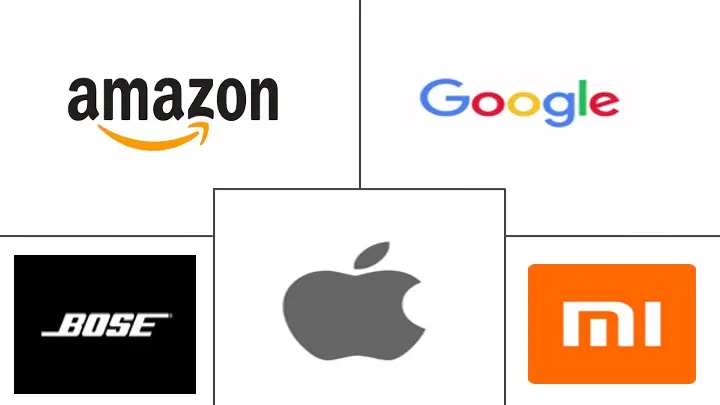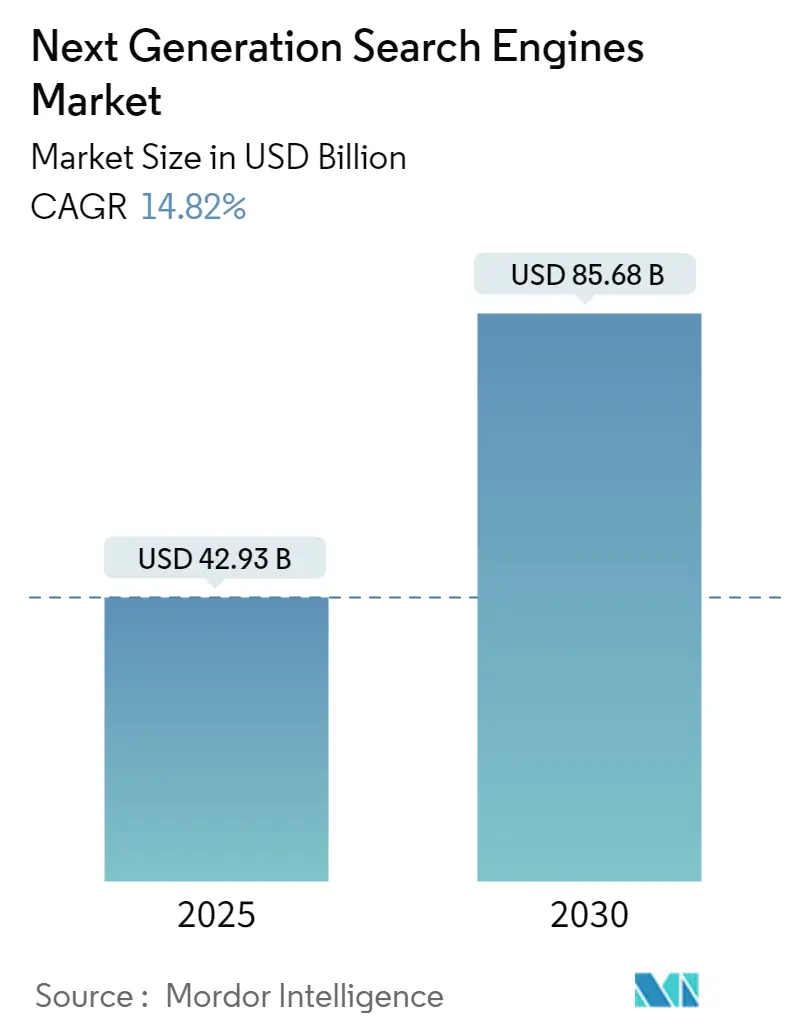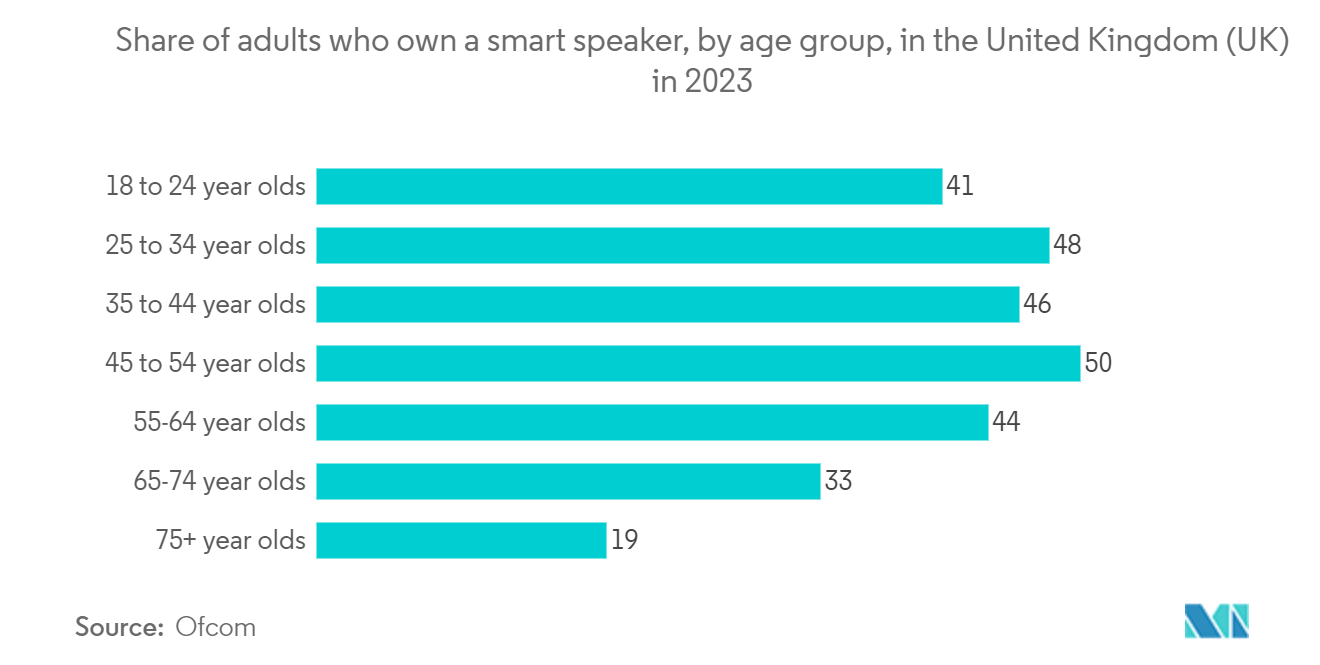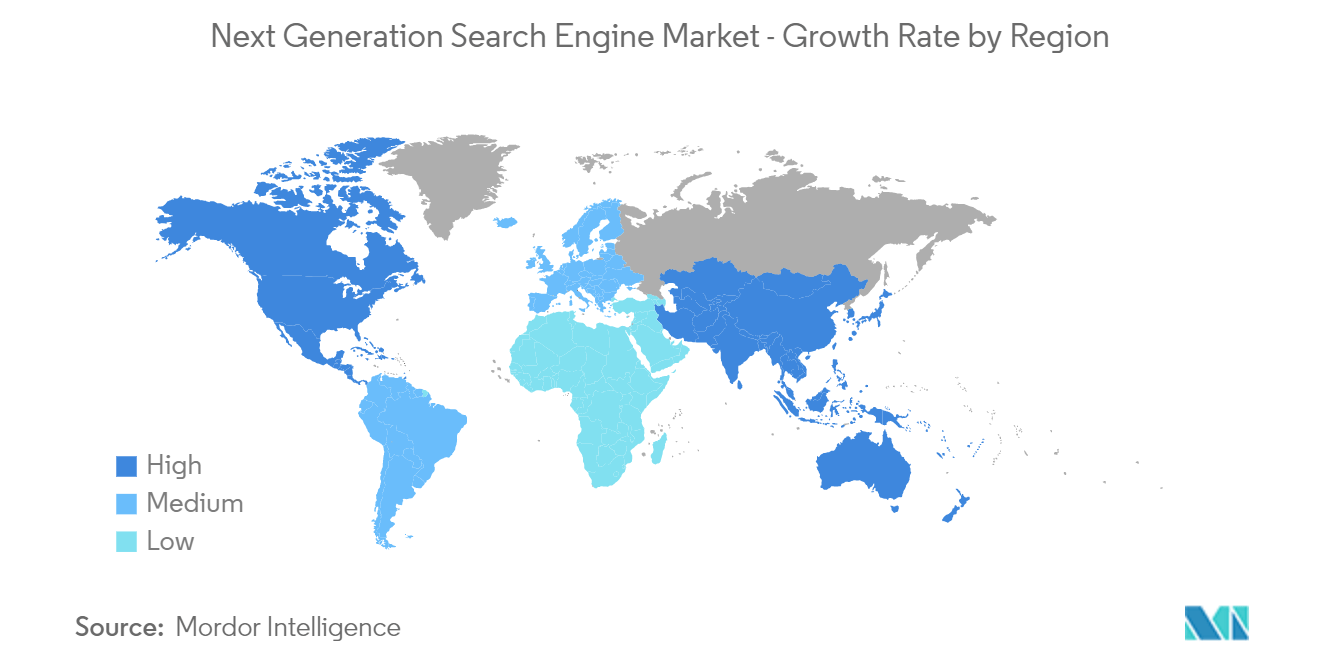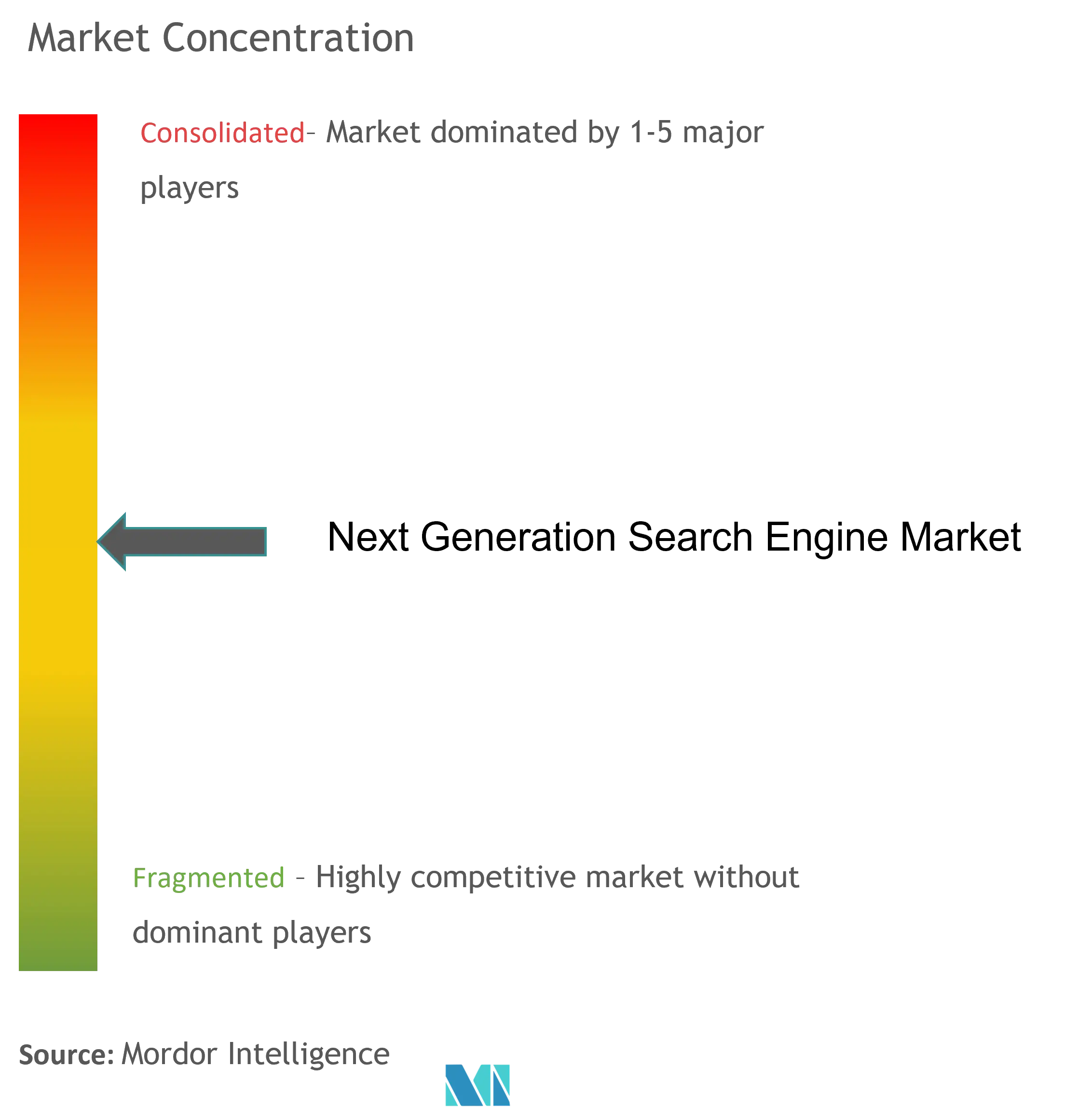Next Generation Search Engines Market Analysis
The Next Generation Search Engines Market size is estimated at USD 42.93 billion in 2025, and is expected to reach USD 85.68 billion by 2030, at a CAGR of 14.82% during the forecast period (2025-2030).
- The next-generation search engine provides an advanced information retrieval model for decision-makers and scientists who wish to gain working knowledge about the search to evaluate available solutions and dialogue with software and data providers. Over the last few years, the number of voice searches has increased exponentially. Also, it is becoming less of a novelty and more like a new standard. Therefore, the next-generation search engines are more oriented toward voice-based search engines.
- Next-generation search engines are also increasing because of deep neural networks, machine learning, and other advancements in AI technologies. Virtual assistants, such as smart speakers, are used for various applications across several end-user industries, such as retail, BFSI, and healthcare. One primary consumer-facing application is a personal assistant. It helps consumers accomplish multiple tasks. For instance, Apple's Siri offers an intuitive interface for connected homes or cars.
- Growing demand for Self-service options indicates rapid growth in consumer demand for more incredible speed and convenience. According to NICE's 2022 Digital First Customer Experience Report, 81% of consumers say they want more self-service options. Yet, only 15% of consumers expressed high satisfaction with the tools provided to them. This trend drives the demand for Next next-generation search engine market.
- Increasing focus on improving Customer Experience across professional services drives the market. Enhancing the customer experience can bring rich rewards. Across industries, satisfied customers spend more and stay more loyal over time. By showing empathy with customers and helping to fix their problems, companies like these can tap into a source of tremendous value, find new business opportunities, and shift their operating model over time.
- Increasing Preference for Live Person Interaction could restrain the market. According to a survey conducted by Liveperson Inc., 87% of consumers worldwide prefer that the companies provide the flexibility to connect interactions across voice and messaging. Such preferences also shift based on different situations and times of the day, demonstrating the importance of allowing consumers to engage on their terms, when, and where they want.
Next Generation Search Engines Market Trends
Self Service and Personal Segment to Witness the Highest Growth
- Smart speakers in personal end-user verticals are expected to hold the majority share. The characteristics expected from a smart speaker nowadays include playing music and controlling smart home devices consisting of voice assistants ready to answer every question.
- The technological enhancements in the development of consumer applications resulted in the integration of smart homes or connected homes. Smart homes' development pushed end users to adopt mobile internet and fast broadband connections across households in the market.
- Voice-activated speakers have become part of people's routines. They provide the ability to use the technology while multi-tasking, as people speak more quickly than they can type (speed), and the increasingly "human" interfaces. Personalized responses are one of the famous use cases of voice search, which Google has attained to a large extent, as Google can know and guess the next question the users will most likely ask. On the other hand, Alexa cannot understand the context to the same extent as Google. Alexa relies on custom-built skills and protocols, whereas Google Assistant can understand specific user requests and further personalize the response.
- Voice users turn to their assistants to accomplish many tasks along their buying journeys, such as product research, price comparison, and adding to cart. A study from Adobe announced the consumer's usage of voice throughout their shopping journeys. The top three activities included product search/research (47%), creating shopping lists (43%), and price comparison (32%).
- The most well-known smart speakers are the Amazon Echo and Google Nest range of products, but there are plenty of third-party speakers, like the Sonos One, which comes with both Alexa and Google Assistant built-in.
- The United States remains a key market for the personal segment, especially voice assistant adoption. According to eMarketer, The number of voice assistants has risen from 103 million to 123 million over the last five years. According to the latest Smart Audio Report from NPR, 24% of Americans aged 18 years or above own at least one smart speaker. The average owner has more than one. A majority of Americans own Alexa. Since Amazon first introduced the Echo, it has become popular in the United States, and it continues to challenge top competitors.
Asia-Pacific Occupies the Largest Market Share
- The Asia-Pacific region currently holds the largest market share for the market studied. The demand for the products in the region, which is primarily from emerging economies, is expected to remain high. The major players are expected to focus chiefly on this region, with the youth as the target audience.
- China, India, Japan, South Korea, Singapore, and other populous nations with consumer product-based demand are expected to remain the target market as product demand in these countries continues to drive the market.
- Moreover, the growth of e-commerce across the world in countries like China and India is anticipated to drive the online distribution channels for selling smart devices. For instance, according to IBEF, the Indian e-commerce market is expected to grow to USD 200 billion by 2026. The development of the industry is driven by increasing internet and smartphone penetration.
- The latest marketing trend is companies implementing voice SEO to attract possible inbound traffic. For instance, China’s iFlytek has a speech recognition system with an accuracy rate of 98%. The system accurately translates English to Mandarin and Mandarin to English, Korean, Japanese, and 22 different Chinese dialects. Its team predicts that it will achieve 99% accuracy within three years.
- Also, the major vendors in this region are expected to target the price-sensitive consumer group by offering products in different price segments. Therefore, they create an opportunity for vendors who offer products at a low price. Vendors with expensive products may target a different customer segment by offering products as a package in collaboration with other electronic products, such as notebooks and tablets.
Next Generation Search Engines Industry Overview
The market faces intense competition, primarily driven by technological innovation as a pivotal growth factor. It maintains a moderate level of concentration, featuring industry leaders such as Amazon, Google, and Apple. Several noteworthy developments have recently taken place:
In May 2023, Google Inc. unveiled plans for an AI-integrated search engine results page. This innovative search engine is currently in its testing phase and promises AI-generated topic summaries that will appear above the conventional search results. Additionally, it will include a highlighted background section, with its color dynamically adjusting according to the user's search intent.
In September 2022, Gen Z entered into a strategic partnership with TikTok to introduce a new search engine. This collaboration leverages TikTok's powerful algorithm, effectively tailored to the preferences of younger users. Notably, this search engine differentiates itself by offering content synthesized and delivered by real individuals on the platform rather than anonymous websites.
Next Generation Search Engines Market Leaders
-
Amazon.com Inc.
-
Apple Inc.
-
Google LLC (Alphabet Inc.)
-
Bose Corporation
-
Xiaomi Inc
- *Disclaimer: Major Players sorted in no particular order
Next Generation Search Engines Market News
- February 2023: Microsoft launched "Binging," a cutting-edge search engine driven by AI. This innovative search engine is powered by a state-of-the-art OpenAI model, specifically fine-tuned to optimize search capabilities. The new OpenAI model draws from the expertise of ChatGPT and GPT-3.5, resulting in even faster and more precise search technology.
- November 2022: Google introduced local search features that were previously showcased earlier in the year. These features include the ability to search your surroundings using your phone's camera. Google has also unveiled an option to search for restaurants based on specific dishes and a new search functionality integrated into Google Maps' Live View.
- November 2022: Up until this point, search insights were exclusively accessible in English, focusing on users from the US, India, Canada, and the UK. However, YouTube is currently experimenting with expanding the availability of Search Insights on the desktop to more languages, starting with Japanese, Korean, and Hindi, and with plans to include additional languages in the future.
Next Generation Search Engines Industry Segmentation
Next-generation search engines are considered advanced search engines incorporated with new technologies, like embedded AI capabilities. Voice-based (Google Assistant, Alexa) and Image-based (Google Lens) searches are regarded as next-generation search engines.
The next generation search engines market is segmented by distribution channel (online and offline), end-user vertical (personal and commercial), and geography (North America, Europe, Asia Pacific, Latin America, and Middle East and Africa).
The market sizes and forecasts are provided in terms of value (USD) for all the above segments.
| By Distribution Channel | Online |
| Offline | |
| By End-user | Personal |
| Commercial | |
| Geography*** | North America |
| Europe | |
| Asia | |
| Australia and New Zealand | |
| Latin America | |
| Middle East and Africa |
Next Generation Search Engines Market Research FAQs
How big is the Next Generation Search Engines Market?
The Next Generation Search Engines Market size is expected to reach USD 42.93 billion in 2025 and grow at a CAGR of 14.82% to reach USD 85.68 billion by 2030.
What is the current Next Generation Search Engines Market size?
In 2025, the Next Generation Search Engines Market size is expected to reach USD 42.93 billion.
Who are the key players in Next Generation Search Engines Market?
Amazon.com Inc., Apple Inc., Google LLC (Alphabet Inc.), Bose Corporation and Xiaomi Inc are the major companies operating in the Next Generation Search Engines Market.
Which is the fastest growing region in Next Generation Search Engines Market?
Asia Pacific is estimated to grow at the highest CAGR over the forecast period (2025-2030).
Which region has the biggest share in Next Generation Search Engines Market?
In 2025, the Asia Pacific accounts for the largest market share in Next Generation Search Engines Market.
What years does this Next Generation Search Engines Market cover, and what was the market size in 2024?
In 2024, the Next Generation Search Engines Market size was estimated at USD 36.57 billion. The report covers the Next Generation Search Engines Market historical market size for years: 2019, 2020, 2021, 2022, 2023 and 2024. The report also forecasts the Next Generation Search Engines Market size for years: 2025, 2026, 2027, 2028, 2029 and 2030.
Our Best Selling Reports
Next Generation Search Engines Industry Report
Statistics for the 2025 Next Generation Search Engines market share, size and revenue growth rate, created by Mordor Intelligence™ Industry Reports. Next Generation Search Engines analysis includes a market forecast outlook for 2025 to 2030 and historical overview. Get a sample of this industry analysis as a free report PDF download.

